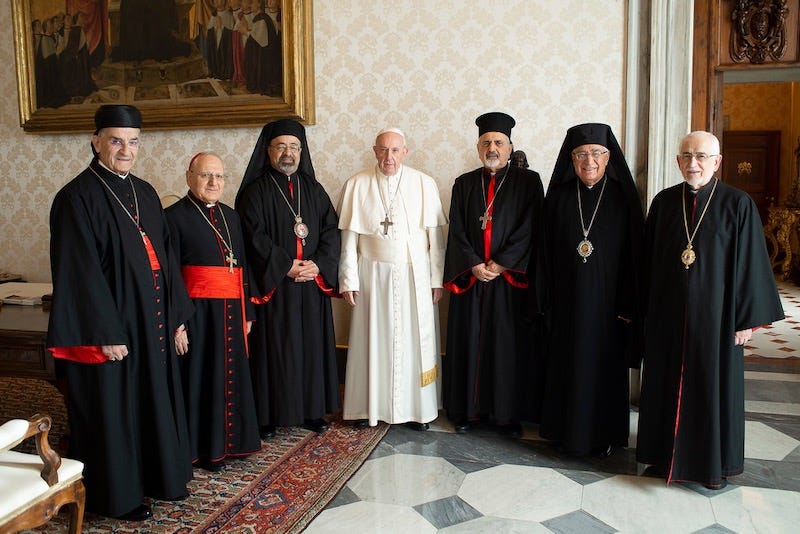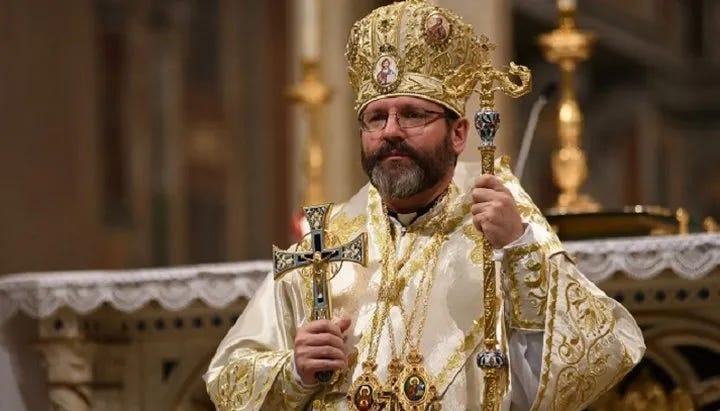
Pope Francis on Monday issued a new motu proprio, a change to canon law impacting the Eastern Catholic Churches of the Catholic communion.
The change puts an age limit on the Eastern Catholic bishops who participate in the synods of bishops of Eastern Catholic Churches — restricting the “active voice” of retired Eastern bishops over the age of 80.
What does that mean? What are these “synods of bishops?” Does this have something to do with the synod on synodality?
The Pillar explains.
Ok, just remind me, what’s an Eastern Catholic Church?
We often think of the Catholic Church as a kind of monolithic global reality, with the pope as the head, and the leaders of various dioceses accountable to him for the leadership of his diocese. We might think that Catholic liturgy is the same in all places, and that the hierarchical structure is fairly straightforward.
But the reality is more complicated than that.
It is true that nearly all of the 1 billion Catholics in the world are members of the Latin Catholic Church — we tend to call them Roman Catholics — and they, generally speaking, worship in much the same way as each other, all around the world, in dioceses that are structured more or less the same.
But the Catholic Church is actually a communion of connected churches — 24 in all — each with its own hierarchy, spiritual jurisdiction, liturgical traditions, culture, and customs. They’re joined by a common faith in the teachings of the Church, along with a sacramental unity, and a common fidelity to the pope as head of the Church.
The largest of those Catholic Churches, by far, is the Latin Catholic Church — you might call it the Roman Catholic Church.
But there are some 16 to 18 million Catholics who are members of the other 23 churches in the Catholic communion — they’re generally called Eastern Catholics, and they include churches like the Ukrainian Catholic Church, the Maronite Catholic Church and the Chaldean Catholic Church in the Middle East, and the Ethiopian Catholic Church and the Eritrean Catholic Church, both in Africa.
Each of those churches has its own bishops and parishes, and is headed by some leadership figure — the patriarch, major archbishop, or a metropolitan.
And those churches have synods?
Some of them do.
The Eastern Catholic Churches headed by patriarchs — six in total — and those headed by major archbishops — another four — each have a leadership and governance institution called the “synod of bishops.”
That institution, the synod of bishops, is composed of all the bishops who belong to the particular Eastern Church — or nearly all of them.
The synod of bishops has deliberative governing authority in the Eastern Catholic Churches in which it exists — it elects a patriarch, is involved directly in the appointment of bishops and the creation of new dioceses (called eparchies), and is required to be either consulted by the patriarch, or to give consent, on a number of important financial, administrative, or personnel decisions for the Eastern Catholic Church in question.
Those synods sound different from the “synod on synodality.”
Yes.
The word “synod” means “coming together,” or “journeying together,” and has a very ancient place in the life of the Church. In the Eastern Christian tradition, a synod refers to a kind of governing council of bishops, who share in the leadership responsibility of a Christian church.
In the West, the term has taken on a broader meaning. The Second Vatican Council called for a consultative body of bishops from around the world to advise the pope, giving both general input on the life of the Church, and gathering a broad group of bishops periodically to discuss particular issues.
Those practices have been in place since shortly after Vatican II, although the ordinary sessions of the synod of bishops - meant as ongoing consultative conversations - have not become as prominent as was initially expected, while extraordinary sessions, called periodically to discuss particular topics, have become more influential in the life of the Church - or at least, they have been given considerably more attention in recent years.
Pope Francis has relied heavily on synods during his papacy — on the Amazon, on youth, on marriage and family — to discuss ideas broadly, even, permitting broad discussion on controversial proposals that have seemed at times to contravene Catholic doctrine.
And in 2021, the pope announced a global consultative and discernment process, called the “synod on synodality,” which was meant to foster discussion among all Catholics — not only bishops — about how the Church could better involve more people in the discernment of God’s will for the life of the Church.
But the Western practice of convoking synods for consultation is a categorically different reality than the notion of synods in the Eastern Catholic Churches, in which synods are composed exclusively of bishops, and exercise governing authority.
So what did Pope Francis do?
In a motu proprio called Iam pridem, the pope restricted the deliberative participation of retired bishops over 80 in the synodal assemblies of the Eastern Catholic Churches.
While retired bishops over 80 can still attend synods of bishops and take part in discussions, they can no longer vote on matters in which the synod exercises deliberative governing authority.
Why did the pope do that?
According to the motu proprio, the pope was asked by a number of hierarchs to restrict the voting authority of older bishops at the synods of bishops. Pope Francis explicitly mentioned “the number of bishops emeritus who participate with an active voice, especially in the election of the bishops and of the [leaders] of respective [Eastern Catholic Churches].”
Some Eastern Catholic sources have told The Pillar they suspect that some patriarchs have complained that older bishops have different priorities on the appointment of bishops than do their younger counterparts, or the patriarchs themselves — and that retired bishops are less in touch with the day-to-day needs of particular dioceses.
While some have suggested that excluding bishops poses ecclesiological questions, it should be noted that the pope, and the synods of bishops themselves, have always had the authority to circumscribe the members, and different Eastern Catholic Churches have allowed participation from bishops far-flung from their home territories in different ways.
But how exactly Iam pridem might the change governance of particular Eastern Catholic Churches remains to be seen.








Interesting.
So, the Patriarchal Churches have true synods of bishops, as they did when they were Orthodox. But these Synods had to ask the Bishop of Rome to fix their problems? But if they really are autonomous they should be able to fix things themselves.
Yes, I know, one can say that the old men in the Synods would still get their way, supposedly there are a great number of the seniors.
Worse things have happened in those Churches, they usually fight among themselves and eventually figure it out.
I find it ironically hysterical that 80 year olds are banned for voting in papal, synodal (nothing like the GSW) and Patriarchal elections. Yet, the Bishop of Rome is 86…Mmm. His predecessors were over 80 beginning with Paul 6 through Benedict 13 (except for John Paul 1).
An old man can’t run a local Eparchy but the Bishop of Rome (86) can run the Universal Church?
Aside from being the Successor of Peter was there a special “ordination” after election that gave the pope greater grace than other bishops?
Sit transit gloria mundi
Another reason I subscribe to the Pillar. Great article